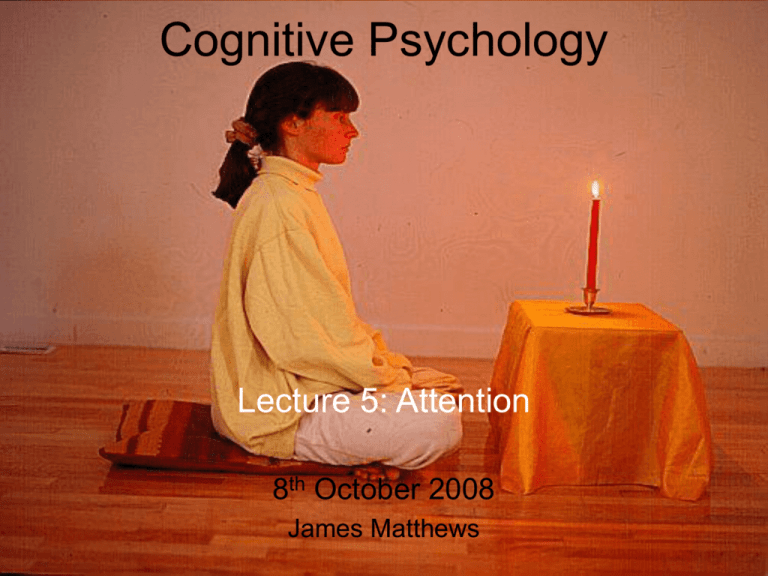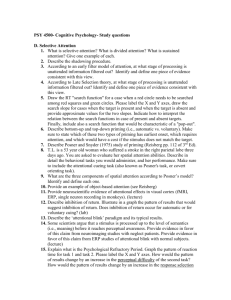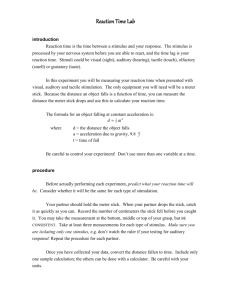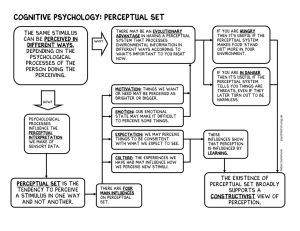CogPsychLecture_Attention
advertisement

Cognitive Psychology Lecture 5: Attention 8th October 2008 James Matthews Attention • Today’s Lecture: • What is Attention • Focused Auditory Attention • Perceptual Load Theories • Focused Visual Attention • Attentional Systems • Crossmodal Effects • Divided Attention & Automatic Processes What is attention? • “concentration of mental activity” - Matlin 2005 • “the taking possession of the mind, in clear and vivid form, of one out of what seem several simultaneously possible objects or trains of thought. Focalisation, concentration, of consciousness are of its essence.” - William James 1890 • Mental spotlight – Focusing – Ignoring • Mental Time – Sharing – Performance of concurrent activities What is attention? Traditionally research has distinguished between two forms of attention: • Focused attention: Participants are told to attend to one stimulus and ignore another. This informs us about the process of selection, and what happens to unattended stimuli. • Divided attention: Participants attend to all stimuli. This informs us about processing limitations and attentional capacity What is attention? B What is attention? D What is attention? G What is attention? J What is attention? P What is happening up here? S What is happening up here? T What is happening up here? Q What is happening up here? M What is happening up here? R What is happening up here? W X What is attention? B Limitations of Research So Far • Research has so far mainly focused on the external determinants of attention. Internal factors can be play a crucial role in attention also. • In experiments participants are often told what to attend to. – Is this anything like our real world experience? • Stimuli are often 2-d, computerised and weird • Attentional models tend to ignore the influence of emotional states – Widely known that anxiety influences attentional processes Attention in the real world “If I hadn’t already got a medal, I might have fought a bit harder. But when you have a medal already, maybe you think about that medal for a moment. It was probably only for a lap…but that is all it takes for a race to get away from you” Sonia O’ Sullivan, 2000 Olympic Games Silver Medalist Attention in the real world “I have learned to cut out all unnecessary thoughts… on the track. I simply concentrate. I concentrate on the tangible on the track, on the race, on the blocks, on the things I have to do. The crowds fades away and the other athletes disappear and now its just me and this one lane” Michael Johnson 5 time Olympic Gold Medalist Attention in the real world “That was the best golf I have ever played. I was in my own little world, focusing on every shot. I wasn’t thinking what score I was on or anything…” Darren Clarke, 1999, having shot a 60 in the European Open Focused Auditory Attention It is possible to hear many conversations, but only listen to one. We can distinguish the conversation we are interested in from the rest of the auditory environment by picking up on a number of features: • Speaker’s voice • Speaker’s location • Content of speech Focused Auditory Attention Cherry (1953) and Moray (1959) carried out dichotomous listening tasks in which participants had to shadow the speech heard by one ear. – Listeners seldom noticed if unattended ear contained foreign language or reversed speech – Listeners always noticed when speech changed to pure tone – Listeners seldom remembered content of unattended speech even if it was a word repeated 35 times – Unattended ear receives practically no processing Focused Auditory Attention Broadbent’s theory: Reported findings where three digits were presented to one ear, and a different three were presented to the other. • Participants chose to recall digits by ear rather than by pair Broadbent’s Theory He accounted for these and other findings in the following way: • Two sources on info gain access in parallel to sensory buffer (this implies the info can linger here) • One input is allowed through a filter based on its basic characteristics, while the other remains on the buffer for later processing • Beyond the filter a mechanism processes the info thoroughly (meaning etc.) Broadbent’s Theory • Explained experimental findings well • Assumed wrongly that the unattended message is always rejected. – People with practice at shadowing were shown to process up to 67% of unattended info (Underwood, 1974) • Did not consider presenting inputs in different modalities. • Wright, Anderson & Stenman (1975) showed processing for unattended words. They conditioned participants to associate some words with mild shock. Broadbent’s Theory System is inflexible: Gray & Wedderburn (1960) Treisman’s Findings • Reported findings that the unattended words were sometimes recalled • Known as ‘breakthrough’ • Occurs when the word in the unattended channel is highly relevant to the content of the attended input Treisman’s Theory Stimulus analysis proceeds through a hierarchy beginning with physical attributes, and ending with semantic processing. If there is insufficient processing capacity, then analysis stops before reaching the end of the hierarchy. There is a threshold of consciousness that partially processed stimuli can exceed. So unattended words may ‘breakthrough’ Deutsch & Deutsch (1963) argue that both inputs are processed fully Focused Aud. Attention Theories • All theories propose that somewhere there is a bottleneck which allows some info through and slows down the rest. • The main difference between these theories is the location of the bottleneck: • Broadbent argues that bottleneck occurs early in the system • Triesman argues that bottleneck occurs mid-way in the system • Deutsch & Deutsch argue that bottleneck occurs late in the system Perceptual Load Theory Lavie (2000) • Everyone has limited attentional capacity • The amount allocated to main task depends on its perceptual load (number of units, type of processing) • Any spare capacity is automatically given to the unattended input Perceptual Load Theory Lavie (2000) • This leads to the conclusion that there will be an early bottleneck when perceptual load is high • And that there will be a late bottleneck when perceptual load is low Perceptual Load Theory Lavie (1995): Participants had to detect either ‘x’ or ‘z’ Low load: ___x_ High load: artxc Large distractor letter also appeared. Either a ‘z’ or ‘s’. The nature of this letter should have a relatively bigger effect on reaction time in the low load condition Perceptual Load Theory The exact nature of ‘perceptual load’ is somewhat vague. Can we measure it? Focused Visual Attention • Studied extensively from a cognitive neuropsychological perspective. • Disorders of visual attention: – Neglect – Extinction – Balint’s Syndrome Neglect • Results in one half of the visual field being ignored • The ignored side is contra-lateral to the brain insult • The person is capable of seeing things to the neglected side if they shift their head position to bring the item to the other side of the visual field Neglect Results from damage to the right parietal lobe Neglect Results from damage to the right parietal lobe Neglect patients fail to notice or respond to objects presented on the left side Extinction • A single stimulus can be judged normally • When two stimuli are presented, one goes undetected • The one that is undetected is on the side contra-lateral to the brain damage. x Extinction A single stimulus can be judged normally When two stimuli are presented, one goes undetected The one that is undetected is on the side contra-lateral to the brain damage. x x Extinction “The presence of extinction only during bilateral stimulation is suggestive of a competative mechanism, whereby the presence of more salient stimulus presented on the same side of the spaceas that of the lesion captures attention and hampers the perception of a less salient stimulus on the opposite side” (Marzi et al, 2001) Balint’s Syndrome • Results from lesions to posterior parietal lobe, or at the parieto-occipital junction • Symptoms: – fixed gaze – gross mis-reaching for objects – simultagnosia (only perceiving one item) Attentional Systems • There is often a distinction made between: • Goal directed attention – Influenced by expectation, knowledge & current goals • Stimulus driven attention – Unexpected occurrences that grab attention Attentional Systems There is often a distinction made between • Goal directed attention – Dorsal fronto – parietal network • Stimulus driven attention – Ventral fronto - parietal network Focused Visual Attention • Location Based Attention: – It is like a spotlight illuminating an area – This area can be narrowed if the task demands it • Object Based Attention: – Attention is directed to objects rather than to an area Location Based Attention Posner (1980) discussed covert attention. Attention can shift in the absence of eye movements. Participants fixated on central point and had to identify a light to the left or right. Central point could be a neutral cross, or a direction arrow Location Based Attention • Posner (1980): • Valid arrows reduced reaction times from control (cross) • Deceptive arrows increased reaction times from control • These happened in the absence of eye movements Location Based Attention • St James (1986) • Participants had to answer about a target stimulus who’s location was indicated beforehand • A distractor caused interference • The area over which interference effects were found was less when the participants had longer forewarning of the target stimulus • Evidence that visual attention zoomed in Location Based Attention (Limitations) • Evidence that attention can be split between two nonadjacent regions of space (see Awh and Pashler, 2000) • Attention can be directed to objects as opposed to areas Object Based Attention • O’Craven et al. (1999) • Two objects appeared superimposed onto each other (face & house) • One moved slightly and participants had to attend to either moving or stationary objects • fMRI scan showed that face area ‘lit up’ when face was being attended to and house area ‘lit up’ when house was being attended to. • Face area = Fusiform face area • House area = Parahippocampal place area Object Based Attention • Marshall & Halligan (1994) Neglect Patient Study • Ambiguous shape was seen as either black object with white background or • White object with black background • They could draw the separating line when asked to draw the left side of the picture, but not when asked to draw the right (neglected) side. • Seen as evidence of object based attention • Other evidence from plant drawings Object Based Attention • It is clear that object based attention is present in humans, but this view fails to explain the findings that show location based attention. • Are the studies ecologically valid??? Crossmodal Effects • In our everyday negotiation of the world we use cues from one sensory modality to direct the attention of the other • Crossing a road: Our ears are drawn by the sound of a car and this then directs our visual attention • In the laboratory, Driver & Spence (1998) used tactile stimulation to improve visual judgement. The tactile cues drew covert visual attention as the person’s eyes remained fixated on the central cross Crossmodal Effects A more spectacular example! Crossmodal Effects The ventriloquist effect happens when we perceive a sound as coming from the most obvious visual source. It is also know as visual capture Crossmodal Effects • Visual capture usually occurs when there is incongruity between vision and audition. We are predominantly visual creatures. • This normally has to do with location. (Think of the cinema) • Auditory capture can happen. This normally occurs in relation to temporal features. • If a light flashes at one rate and a sound beeps at another, we perceive the light to be flashing at the auditory rate Divided Attention Divided Attention • Easy for some things: – Driving and talking • Hard for other things: – Patting head and rubbing stomach Factors effecting dual task performance • Task similarity: • Easy to do things which are dissimilar (drive & talk). • We recall unattended pictures when shadowing an auditory stream. • If we have to do different things with items in the same modality it is difficult Factors effecting dual task performance • Practice: • Spelke et al. (1976) trained people to read and understand short passages, while writing down words from dictation. • The performance of participants improved hugely over 6 weeks of training • “People’s ability to develop skills in specialised situations is so great that it may never be possible to define general limits on cognitive capacity” • Expertise: – Beilock et al (2002) – Experts utilise less attentional resources Factors effecting dual task performance • Task Difficulty: • Easier to drive and chat, than drive and conduct a job interview • This is obvious, but how do we define task difficulty Automatic Processing The practice effects shown in Spelke et al. (1976) prompted speculation as to how we can become so good at difficult tasks The common explanation is that some processing becomes automatic. Automatic Processing • Automatic processes do not tax attention: – They are fast – They do not reduce capacity for performing other tasks – They are unavailable to consciousness – They can be unavoidable Automatic Processing The Stroop Effect Automatic Processing Attention Today’s Lecture: • What is Attention • Focused Auditory Attention • Perceptual Load Theories • Focused Visual Attention • Attentional Systems • Crossmodal Effects • Divided Attention & Automatic Processes Reading Eysenck & Keane: Chapter 5 Matlin: Chapter 2









